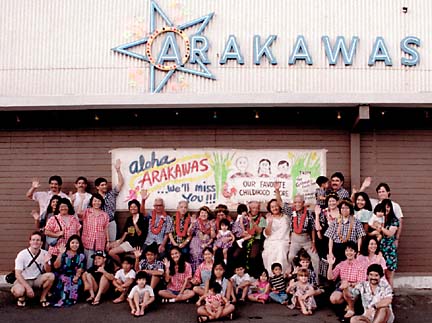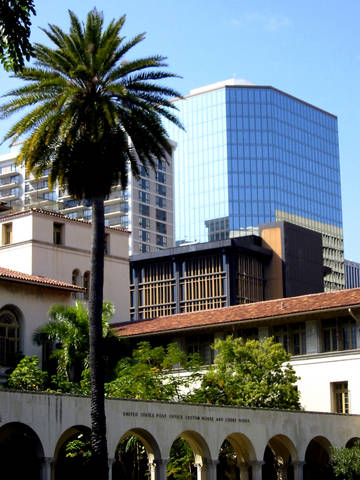
Arakawa’s of Waipahu: Small Plantation Store to Local Landmark
The famous Arakawa store of Waipahu was founded in 1909 by Zenpan Arakawa, an issei from Okinawa. It was known for its ohana spirit. As soon as walked in you felt like family as a member of the Arakawa family greeted you with: “Howzit and how may I help you?”
Zenpan Arakawa came to Waipahu from Okinawa at age 19. At 96 pounds he was too small to cut cane so he was given the job of being a water boy to the larger plantation workers. In addition to bringing them water, Zenpan also ran errands for them. In this way he got to know all the workers and what they needed.
In 1909, Zenpan and his wife Ruth, left the plantation and opened Arakawa Shoten on Waipahu Street. They sold kau-kau bags, footwear, work clothes and women dresses. In 1912, the store moved to Depot Road. In 1955, Zenpan opened the 1 ½ level store crammed with all sorts of merchandise, from clothing and jewelry to hardware, food, and sporting goods. Newspaper journalist Melvin Masuda wrote: “Going to Arakawa’s was like stepping back in time, back to the old sugar plantation days when life in Hawaii seemed simpler and more relaxed.”
The store’s special ambience was based on the planned chaos concept of retailing. Far from being random, the store’s distinctive style reflected Shigemi Arakawa’s “creative marketing genius.” On buying trips around the world he had the talent for spotting things that would catch people’s fancy.
Arakawa’s was also on the forefront of competitive retailing. Goro Arakawa came up with the concept of “if you buy the item here and later find it cheaper elsewhere, you can have it from us at the lower competitor’s price.” (in Masuda)
Branding Strategies
The store became well known for having everything a home needed. The store logo and advertisement all said “Waipahu.” Goro Arakawa recollected:
Our identity was tied to Waipahu. . . . . When people thought of Waipahu, they thought of Arakawas. We had many opportunities to open stores in Kapahulu and Kalihi, but we decided to expand the Waipahu store and get people to come to us.
We’d run ads that said, ‘Only 10 minutes from Hickam.’ We wanted to make it seem like a pleasant outing. Of course, you had to drive like hell to get here in 10 minutes! (in Sigall)
Identifying Arakawa’s with Waipahu helped build up customer loyalty among nearby residents and gave the store a distinctive, if not exotic identity, for those who lived outside Waipahu. Back in the days before the H-1 freeway going to Waipahu was like an adventure for the Honolulu townies.
Ahead of its time Arakawa’s used creative branding strategies. One was directed at the customer’s ear – the jingle. Arakawa’s used a rooster crowing in all its radio and TV ads: “Arakawas on historic Depot Road.... cock-a-doodle-do.... in Waipahu.” To gain further publicity Arakawa’s held live radio contests in its parking lot. People would wear rooster costumes and compete for prizes.
Another creative branding strategy was directed to the customer’s eye – the palaka shirt. Arakawa’s marketed men and women’s clothes made from palaka. The visually distinctive “pattern of the Islands” (Susan Yim) helped created a sense of identity and group loyalty. Where the Aloha shirt and the muumuu said “Hawaii,” palaka said “Hawaii plantation.”
Ending Well
In the 1990s, retail marketing in Hawaii underwent massive changes with the entry of huge retailers like Wal-Mart and Costco. Goro recounted:
We saw the handwriting on the wall. .... Wal-Mart and Costco were changing the retail landscape. My brothers and sister were all in our 70s, and retail is a younger person's game. (in Sigall)
After 85 years in business Arakawas closed with a big party for all its employees.
Doing Well
The immigrants’ dream is to do well and to provide a good life for their children. We see this, not only in Zenpan founding the iconic store, but also in the life of his children. His fourth son, the late Shigemi, did well on the language tests and was placed in the English Standard program at August Ahrens School in Aiea then went to Mid Pacific Institute in Manoa. His youngest child, Goro Arakawa, is a country boy with an Ivy League education. Goro studied at Columbia University Business School in New York. Among his grandchildren are: Myron Arakawa, a college counselor at Punahou School; Cosmo Arakawa, vice principal for Kapolei Elementary School; and David Arakawa, executive director for Land Use Research Foundation and President of Hawaii United Okinawa Association (2007).
Sources
Melvin Masuda. 2002. “Ohana set tone for Arakawa’s” in Honolulu Star-Bulletin. 29 September 2002.
__________. “Obituary: Shigemi Arakawa” in Honolulu Star-Advertiser. 2 September 2012.
Bob Sigall. “Selling Point: You’ll find it at Arakawa’s” in HawaiiBusiness. June 2006.
David Arakawa. 2006. “President’s Message” in Uchinanchu: The Voice of the Hawaii United Okinawan Association.

